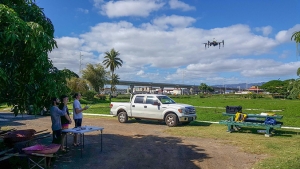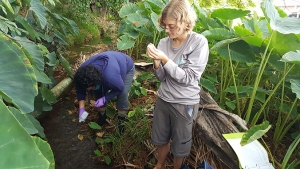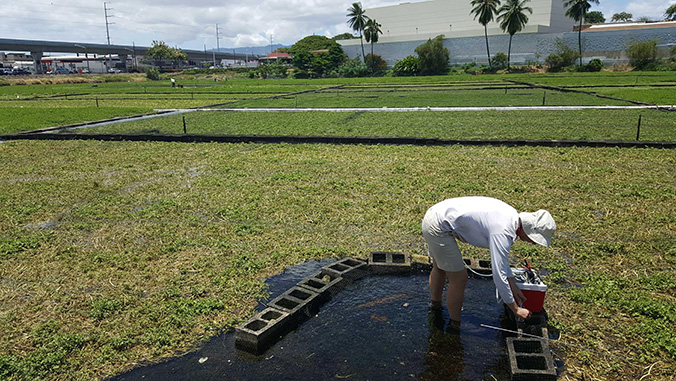
In ʻAiea, scientists wade through cool, ankle-deep water around the watercress patches at Sumida farm. They are researching whether rising temperatures and changing water chemistry may be hurting the farm’s crops.
University of Hawaiʻi at Mānoa researchers funded by two National Science Foundation (NSF) programs are working with a third-generation farming family to better understand challenges to their livelihoods and those of other small farmers on Oʻahu. Active Societal Participation in Research and Education (ASPIRE), and ʻIke Wai, a program that studies Hawaiʻi‘s aquifers with a goal of ensuring future water security, are partnering to make this possible.
“[Sumida Farm] is a sort of a ‘canary in the mine’ for problems faced by small farmers throughout the state, and particularly in the Pearl Harbor aquifer,” said Jennifer Engels, the UH Mānoa research affiliate who leads ASPIRE. “They are one of the few remaining economically viable small farms in the state, but a combination of climate change, over-pumping of the adjacent groundwater reserves, and increasing operating costs are making it hard for them to stay in business.”
The Kahuawai Spring, now called Kalauao Spring, provides all of the farm’s water, but water flow has decreased from approximately 20 million gallons per day in the 1970s down to as little as 5 million gallons per day currently.
Farm owners Barbara and David Sumida remember paddling small boats in the river that came from the spring. Brother Stephen Sumida said, “Not only us kids in the family, but also the entire community of kids of ʻAiea and of Hālawa Housing who played every summer day in the waters of Kalauao for generations, have been wondering what happened to our stream.”
Collaboration and research

“The Sumida family has been so gracious in welcoming us into their farm, and they have provided much of the context and farm history that informs our science,” said Engels, who, with the help of the working group there, created a multimedia story map that helps to document the farm’s cultural and historical significance.
Researchers used community member interviews and information translated from Hawaiian newspapers to understand the historical and cultural background of water in the area. Hawaiian-language specialist ʻAnoʻilani Aga and the team from the UH Institute of Hawaiian Language Research and Translation discovered many moʻolelo (stories) from their translations related to Kahuawai Spring, a wahi pana (sacred place) and favorite swimming pool for its fresh cold waters.
ʻIke Wai researchers Kimberly Burnett, Christopher Wada, Ahmed Elshall and Leah Bremer are working with Sumida Farm to create a pumping model that studies water management and looks at the big picture. In one scenario, using the U.S. Geological Survey’s model of Pearl Harbor aquifers, wells around the farm could be pumped less, which might increase spring flow to the farm.

Kewalo Marine Lab microbiologists Kiana Frank and Sheree Watson are examining microorganisms in the water and on rotting watercress plots to look for pathogens that could be causing disease.
UH Mānoa geologist Henrietta Dulai is using a monitor in the fields to collect water chemistry data to show how much groundwater is in the aquifer and how the levels of water flow and salinity changes over the seasons. She is examining the chemical fingerprints left behind by rain, rocks and humans, which can include wastewater leakages and past agricultural activities.
“Preserving adequate spring flow of excellent water quality should be our priority not just at this farm, but overall in the state,” said Dulai. “It is natural that we want our food to be grown with clean water and that water should always be available. But preserving clean and abundant spring flow also reflects our stewardship of the land.”
This work was supported by NSF EPSCoR funded project (award #1557349).
Written by Alice Kim.


